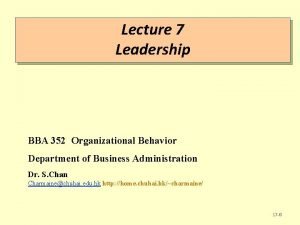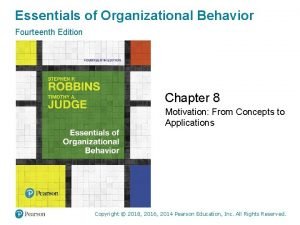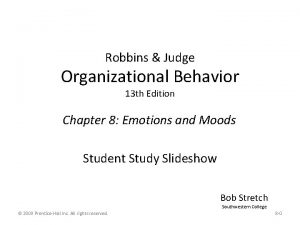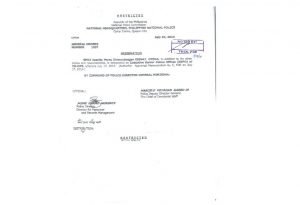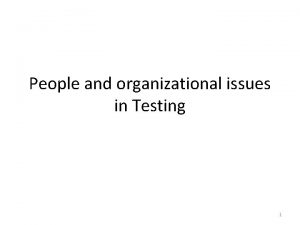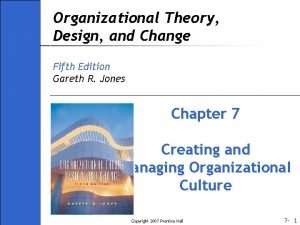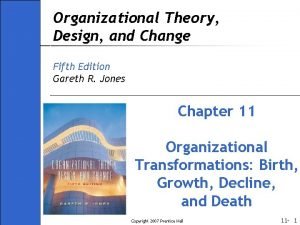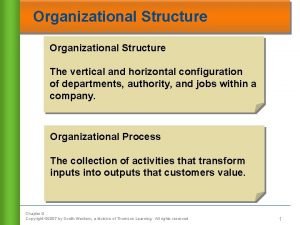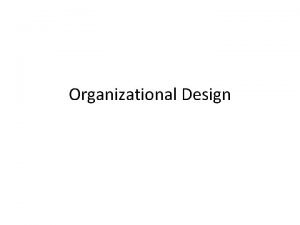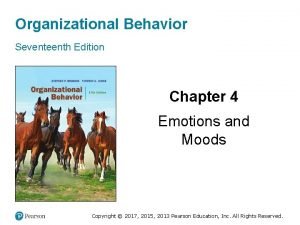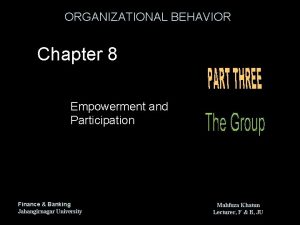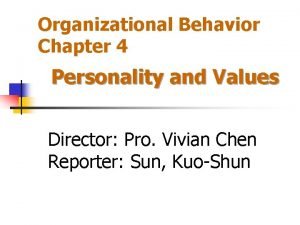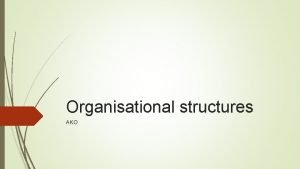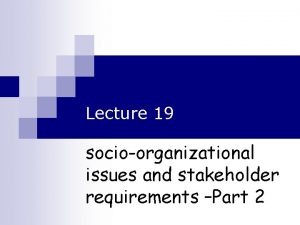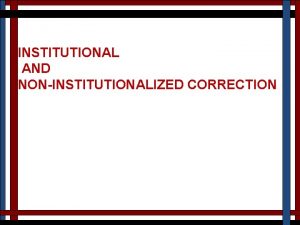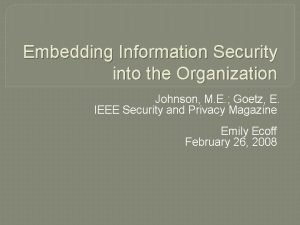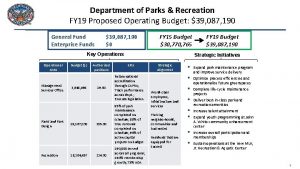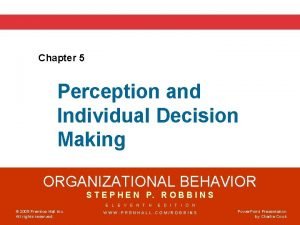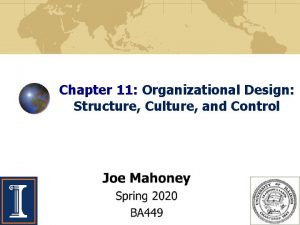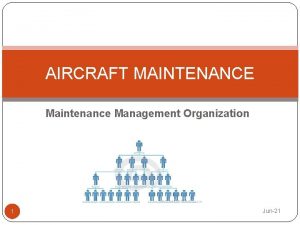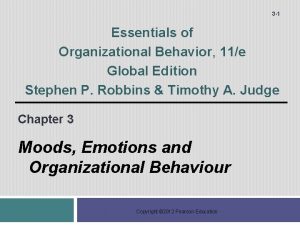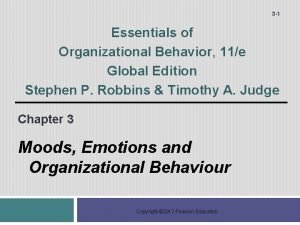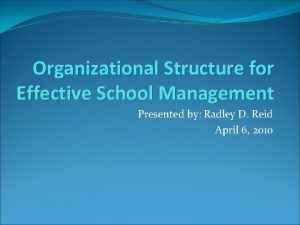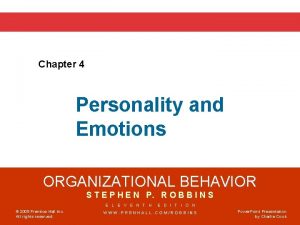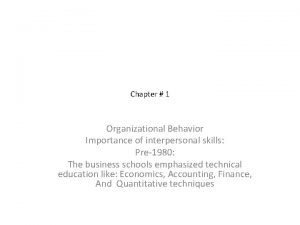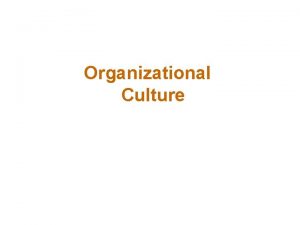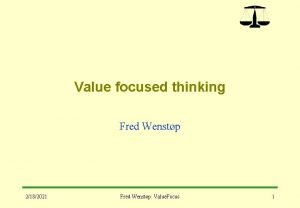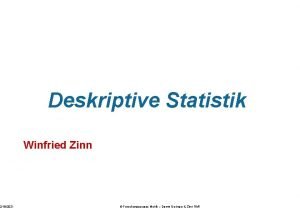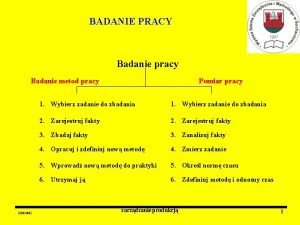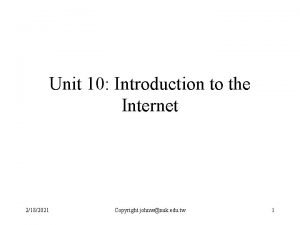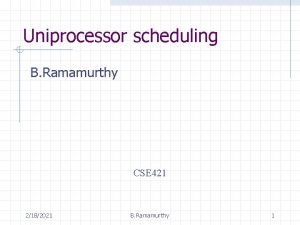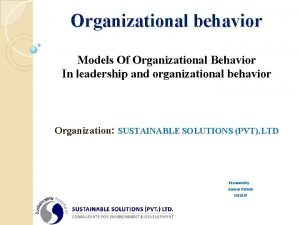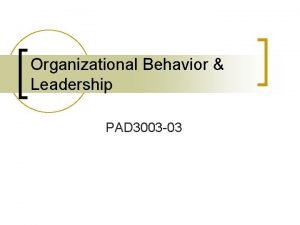Leadership and Organizational 2182021 1 Leadership Who is




































- Slides: 36

Leadership and Organizational 2/18/2021 1

Leadership… Who is a leader? What quality a leader should have? Whom to call a leader? Everybody seems to have a say when it comes to Leadership!! Historical figures (Alexander, Napolean, Hitler? ? ) From business world (JRD Tata, Dhirubhai Ambani, Bill Gates etc. . ) 2/18/2021 2

Leadership… Influence is the process of affecting potential behavior of others. Whereas, Power is the capacity to exert influence. Sources of Power (French & Raven, 1959) Position Power: Legitimate Power, Reward Power, Coercive Power. Personal Power: Referent Power and Expert Power (information power) 2/18/2021 3

Trait Theory Leadership Traits: represent the personal characteristics that differentiate leaders from followers. Historic findings reveal that leaders and followers vary by - intelligence - dominance - self-confidence - level of energy and activity - task-relevant knowledge Contemporary findings show that - people tend to perceive that someone is a leader when he or she exhibits traits associated with intelligence, masculinity, and dominance - people want their leaders to be credible - credible leaders are honest, forward-looking, inspiring, and competent The trait theory provides descriptive insights but has little analytical or predictive power. 2/18/2021 4

Trait Theory (continued) Gender and leadership - men and women differ in the type of leadership roles they assume in work groups: men display more task leadership and women exhibit more social leadership - leadership styles vary by gender: women are more democratic and men are more autocratic and directive - female and male leaders are equally effective - men are perceived as more effective than women when the job is defined in masculine terms, and women are more effective than men in roles defined in less masculine terms - male leaders are perceived as more effective than females when there a greater percentage of male leaders and male direct reports; the same positive bias is not true for women leaders 2/18/2021 5

Group Exchange Theory l This theory posits that there must be positive exchange between the leader and followers in order for the group goals to be accomplished. l Followers impact on leaders- Some important research studies indicate that followers/subordinates may actually affect leaders as much as leaders affect them. l Vertical Dyad Linkage model (VDL)- It states that leaders treat individual subordinates differently. They develop dyadic (two persons) relationships which affect the behavior of both leader and subordinates. 2/18/2021 6

House’s Path-Goal Theory Employee Characteristics - Locus of control - Task ability - Need for achievement - Experience - Need for clarity Leadership Styles - Directive - Supportive - Participative - Achievement oriented Employee Attitudes and Behavior - Job satisfaction - Acceptance of leader - Motivation - Performance Environmental Factors - Employee’s task - Authority system - Work group 2/18/2021 7

Path Goal Theory 1. 2. 3. 4. Directive Leadership: This style is similar to that of the Lippitt and White authoritarian leader. Subordinates know exactly what is expected of them, and the leader gives specific directions. There is no participation by subordinates. Supportive Leadership: The leader is friendly and approachable and shows a genuine concern for subordinates. Participative Leadership: The leader asks for and uses suggestions from subordinates but still makes the decisions. Achievement—Oriented Leadership: The leader sets challenging goals for subordinates and shows confidence that they will attain these goals and perform well. 2/18/2021 8

Path Goal Theory Two of the situational factors that have been identified are the personal characteristics of subordinates and the environmental pressures and demands facing subordinates. With respect to the first situational factors, theory asserts: “Leader behavior will be acceptable to subordinates to the extent that the subordinates see such behavior as either an immediate source of satisfaction or as instrumental to future satisfaction. ” 2/18/2021 9

Path Goal Theory And, with respect to the second situational factors, theory states: “Leader behavior will be motivational (e. g. , will increase subordinate effort) to the extent that (1) it makes satisfaction of subordinate needs contingent on effective performance, and (2) it complements the environment of subordinates by providing the coaching, guidance, support and rewards which are necessary for effective performance and which may otherwise be lacking in subordinates or in their environment. ” 2/18/2021 10

Path Goal Theory Research findings: 1. Studies of seven organizations have found that leader directiveness is (a) positively related to satisfaction and expectations of subordinates engaged in ambiguous tasks and (b) negatively related to satisfaction and expectancies of subordinates engaged in clear tasks. 2. Studies involving ten different samples of employees found that supportive leadership will have its most positive effect on satisfaction for subordinates who work on stressful, frustrating, or dissatisfying tasks. 2/18/2021 11

Path Goal Theory 3. In a major study in an industrial manufacturing organization, it was found that in nonrepetitive, egoinvolving tasks, employees were more satisfied under participative leader than under non-participative leader. 4. In three separate organizations it was found that for subordinates performing ambiguous, nonrepetitive tasks, the higher the achievement orientation of the leader, the more subordinates were confident that their efforts would pay off in effective performance. 2/18/2021 12

Hershey and Blanchard’s Life–Cycle or Situational Approach Two major styles of leadership 1)Task style and 2) Relationship style l The level of maturity is defined by three criteria a) Degree of achievement motivation, b) Willingness to take responsibility and c) Amount of education and/or experience. 2/18/2021 13

Hershey and Blanchard’s Life–Cycle or Situational Approach Four basic styles 1) Telling style – This is high task, low relationship style and is effective when followers are at a very low level of maturity 2) Selling style - This is high task, high relationship style and is effective when followers are on the low side of maturity 3) Participative style - This is low task, high relationship style and is effective when followers are on the high side of maturity 4) Delegating style - This is low task, low relationship style and is effective when followers are at a very high level of maturity 2/18/2021 14

Likert’s Four Systems of Management l l System 1 (Exploitative Autocratic) – Manager has no trust or confidence in subordinates and subordinates do not feel free with their superior. System 2 (Benevolent Autocratic) - Manager has condescending trust and confidence but subordinates do not feel very free with their superior. System 3 (Participative) - Manager has substantial but not complete trust and confidence and subordinates rather feel free with their superior. System 4 (Democratic) - Manager has complete trust and confidence in subordinates in all matters and subordinates feel completely free with their superior. 2/18/2021 15

Empirical support for Likert’s Four Systems of Management l Likert and his colleagues have quite consistently found that high producing units were described according to system 3 and 4 while low producing units fell under system 1 and 2. These responses were given irrespective of the manager’s field of experience. 2/18/2021 16

Ethical and Unethical characteristics of Charismatic leaders l l l Ethical Uses power to serve others Aligns vision with followers’ needs and aspirations Consider and learns from criticism Open, two way communication 2/18/2021 l l l Unethical Uses power only for personal gains Promotes own personal vision Censures critical or opposing views One way communication 17

Ethical and Unethical characteristics of Charismatic leaders (contd…) l Ethical l Unethical l Stimulates followers to think independently and to question the leader’s view Coaches, develops, and supports followers; shares recognitions with other Relies on internal moral standards to satisfy organizational and societal goals l Demands own decisions to be accepted without question l Insensitive to followers’ needs l Relies on convenient external moral standards to satisfy self interests l l 2/18/2021 18

Concept of employment • Commitment: loyalty - devotion or dedication, e. g. to a cause, person, or relationship. • Morale: a: the mental and emotional condition (as of enthusiasm, confidence, or loyalty) of an individual or group with regard to the function or tasks at hand b: a sense of common purpose with respect to a group. 2/18/2021 19

Engagement Defined l l “Engaged employees are defined as those who are “mentally and emotionally invested in their work and in contributing to their employer’s success. ” “In a nutshell, engaged employees brings all of themselves to work. ”(Jo. Anna Brandi, president of Jo. Anna Brandi and Co. )

Employee Engagement The Business Impact of Employee Engagement: The Corporate Leadership Council has completed a study of the engagement level of 50, 000 employees around the world. And found that… Those employees who are most committed (engaged) perform 20% better and are 87% less likely to leave the organization. Source: Corporate Leadership Council

Motivation “You can’t motivate other people. You can only influence what they’re motivated to do. ” “People don’t change that much. Don’t waste time trying to put in what was left out. Try to draw out what was left in. That is hard enough. ” Source: First Break All the Rules

Motivation is……. “Motivation is a fire from within. If someone else tries to light that fire under you, chances are it will burn very briefly. ” Dr. Stephen Covey “Motivation is a function of growth from getting intrinsic rewards out of interesting and challenging work. ” “Motivation is based on growth needs. It is an internal engine. ” Frederick Herzberg Retrospective Commentary on 1968 HBR article “How Do You Motivate Employees”

Motivation Ladder Price of Admission: Covering Basic Needs • Competitive pay/benefits • Job fit • Working conditions • Relationship with supervisor ON ATI • Money • Prizes • Awards • Celebrations TIV Short-term Motivation (External Commitment) MO Sustained Motivation (Internal Commitment) Meeting Advanced Needs • The work itself • Responsibility • Social interactions • Achievement • Recognition • Growth • Advancement

What Is a High Performing, Motivated Workforce? l l l Greater than 1/3 employees consistently exceed expectations Average worker performs higher than industry Strong emotional commitment Collective performance of major segments…forms core of competitive advantage Leaders believe front line people are key to success and engage employees emotionally Source: Peak Performance, Jon Katzenbach and rationally

“Things that matter to Employees that most Companies aren’t doing well!” 1. 2. 3. 4. 5. Feeling appreciated for the work they do. Not working in a stressful environment (i. e. call handling time pressure). Being valued and respected within the center and organization. Career opportunities for advancement within the center and organization. The Center effectively utilizes employee’s knowledge and skills. Source: SQM Group Study for Manpower

A Motivation Problem? As many as 34% of employees who quit a job cited a lack or limited appreciation of their contributions as the reason. Robert Half International

What Happens in the Center… • No news is good news, we’ll let you know if something is wrong • Negative reinforcement is common • Attempts at positive reinforcement are disconnected and remote (financial incentives, contests, reports) • Constant redirection & correction

What Happens in the Center… No response Wow! I did it! No response I think that’s how I was supposed to do it? It doesn’t matter if I do it or not…

Praise Should Be. . . l Specific l Sincere l Individual l Proportionate l Frequent & ongoing l Encouraging

Praise Should Be. . . Specific l Eliminate generic, blanket praise (e. g. , “nice work”) l Use descriptive language, quotes, examples l Describe exactly what was positive - the behavior, the result

Praise Should Be. . . Sincere l Communicate your concern, excitement, interest, investment l Express confidence the agent can/will succeed l Convey through word choice, tone of voice, body language

Praise Should Be. . . Individual l A view of the “big picture” l Continuity between coaching sessions l Refer to individual challenges, struggles, talents, strengths

Praise Should Be…Proportionate l Behavior being praised l Extent to which a goal was achieved l Importance of the goal

Praise Should Be. . . Encouraging l Clarify exactly what you’d like to see happen in the future l Provide recognition to inspire reoccurrence l Stress that the behavior is valued, applauded

Practical Application l Practice, Encourage throughout the Center l l l l Manager to Reports Peer to Peer Across the Call Center Coach to Agent Make it part of your weekly To-Do list Track the type & amount of praise being delivered Measure the Results Celebrate!
 Bba in leadership and organizational dynamics
Bba in leadership and organizational dynamics Chapter 12 leadership organizational behavior
Chapter 12 leadership organizational behavior Organizational behavior chapter 8
Organizational behavior chapter 8 Transactional vs transformational
Transactional vs transformational Situational leadership vs adaptive leadership
Situational leadership vs adaptive leadership Enthusiastic beginner disillusioned learner
Enthusiastic beginner disillusioned learner Emotions and moods in organizational behavior
Emotions and moods in organizational behavior Pnp organizational structure 2022 with names
Pnp organizational structure 2022 with names People and organizational issues in testing
People and organizational issues in testing Organizational theory design and change
Organizational theory design and change Weitzel and jonsson’s model of organizational decline
Weitzel and jonsson’s model of organizational decline Vertical and horizontal organizational structure
Vertical and horizontal organizational structure Software organization structure
Software organization structure Emotions and moods in organizational behavior
Emotions and moods in organizational behavior Empowerment and participation in organizational behavior
Empowerment and participation in organizational behavior 4 personality types
4 personality types Lyngel
Lyngel Differences between tall and flat organizational structure
Differences between tall and flat organizational structure Catwoen
Catwoen He sponsored house bill 393
He sponsored house bill 393 Food and beverage organizational chart
Food and beverage organizational chart System design proposal
System design proposal Johnson and johnson organizational structure
Johnson and johnson organizational structure Parks and recreation organizational chart
Parks and recreation organizational chart Organizational feasibility in system analysis and design
Organizational feasibility in system analysis and design Perception and individual decision making
Perception and individual decision making Sbu m-form structure
Sbu m-form structure Organizational design: structure, culture, and control
Organizational design: structure, culture, and control Deped human resource development plan
Deped human resource development plan Mro organization chart
Mro organization chart Emotions and moods in organizational behavior
Emotions and moods in organizational behavior Emotions and moods in organizational behavior
Emotions and moods in organizational behavior School organisation structure
School organisation structure Personality attributes influencing ob
Personality attributes influencing ob Chapter 18 organizational change and stress management
Chapter 18 organizational change and stress management Organizational and interpersonal skills
Organizational and interpersonal skills Interpersonal and organizational communication
Interpersonal and organizational communication
